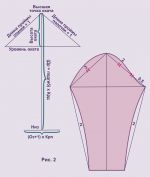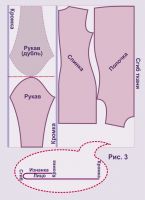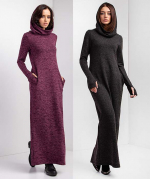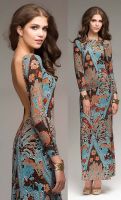 This base is a ready-made dress pattern or a turtleneck pattern, if you make it shorter.
This base is a ready-made dress pattern or a turtleneck pattern, if you make it shorter.
And if you are on the fitting change the shape of the neckline, you will get a unique model, sewn with your own hands.
The stretch base (pattern) is also ideal for modeling all kinds of models, and also, if you make small changes to it, for knitted products. In the photo on the left you can see examples of dresses, ready-made patterns for which they are modeled on this basis. Download links for all of these patterns are at the bottom of the article.
The article considers two options for building a stretch base: “competent, but complex” and “simple and convenient”.
 In the calculations of the first variant, stretch coefficients (in the article on taking measurements, paragraph 8),
In the calculations of the first variant, stretch coefficients (in the article on taking measurements, paragraph 8),
in the second - elongation coefficients are “laid” already on the finished pattern (see "Working with patterns" Fig. 10-11).
I like the second method better, as it allows you to use the finished template several times, applying different coefficients or ignoring them.
Stretch base pattern is NOT suitable for patternless cutting, despite the ease of construction.
Download ready-made dress patterns on this basis
Building the back in a pattern based
We will consider the left vertical cut of a sheet of paper (or plastic film) middle back line and start, as usual, with contour lines (Fig. 1).
Attention! If you, relying on my experience, decide without reading the article to the end, to build a base pattern, simply DO NOT perform the last step in the formula, that is, DO NOT multiply by a coefficient. For convenience, these steps are highlighted.
Bottom level - if the back and shelf will be located on the same sheet, step back from the lower horizontal cut 2 см, they will be needed to lengthen the shelf along the half-skid. If the drawings of the shelves and backs will be made on different sheets, then the horizontal cut of the sheet can be considered the bottom level. The angle between it and the middle line of the back should be strictly straight. Lay up from the bottom
(Du + for bottom processing) multiply Krd
Let's draw waist level and measure down from it
18 multiply by Krd
To find original lines from the waist up -
Ds multiply by Krd
Level of barrel (or armholes - in this basis they coincide, both in the drawing of the shelf and in the drawing of the back) - from the waist up, while the barrel measurement should be as high as possible -
Dboch multiply by Krd
Building a neck. Sprout width:
(1/3 Ssh + 0,5 cm) multiply by kp
Plant height = 1/3 plant width
Please note: in the calculation sprout height factor is not involved.
 shoulder point, as in other bases, is located at the intersection of two arcs made with a compass from the side point of the neck and from the midpoint at the waist. The compass opening for the first arc is
shoulder point, as in other bases, is located at the intersection of two arcs made with a compass from the side point of the neck and from the midpoint at the waist. The compass opening for the first arc is
Dp multiply by Krp,
and for the second -
VPK multiply by Krd
Now, the shoulder point connects to the side neck point.
In order to save fabric or because of the location of the fastener, as well as for figures with “Latin American” buttocks, it is advisable to perform a middle seam ("Discourse on the Middle Seam" и "Removal of measurements"). In knitwear, only the lumbar deflection is important. Stepping back by the amount of deflection at the waist, bring out the middle seam.
After that, we will limit the back detail in width at the level of the armhole.
Back width to armhole corner:
(Wh + 1 cm) multiply by kp
Back width to side seam
(1/2 (Cr + Pg) minus 2 cm) and multiply by kp
Back width at waist
(1/2 (St + Fri) minus 2 cm) and multiply by kp
Hip Width
(1/2 (Sat + Fri) minus 2 cm) and multiply by kp
The armhole and side seam, as usual, are drawn with smooth lines.
A short discussion on loose fit allowances
Among people who do not sew, there is an opinion that a stretch product can and should be bought 2 - 3 sizes smaller, therefore the image of a woman in a blouse that bounces on her belly, promising to burst on her chest as soon as she tells everyone, has become the aesthetic norm today how many folds of fat gather over the thighs of her mistress.
Tailors, unfortunately, did not "break away from the people" and offer stretch "cut two sizes smaller." Perhaps, in some cases, if you are going to do a laborious fitting and / or did not attend math classes at school, you can do this. But it is better if in a tight-fitting product
from thin stretch fabric Pg = 2 cm, Pt = 0 - 2 cm, Pb = 2 cm;
from loose knitwear Pg = 3 cm, Pt = 1 - 2 cm, Pb = 2 cm.
For combidresses, the increase can be reduced to zero.
When using Kr and performing accurate calculations, the product will sit flawlessly.
How to build a shelf in a pattern
 Extending or copying lines bottom, hips, waist и barrel. Measure from the waist up
Extending or copying lines bottom, hips, waist и barrel. Measure from the waist up
dpt multiply by Krd
and carry out original shelves.
From the side point of the back along the hips, we measure the width of the shelf along the hips:
(1/2 (Sat + Pb) + 2 cm) and multiply by kp
Having limited the shelf in width, we carry out half skid vertical.
Neck:
Neck Width = Stem Width
Neck Depth = Sprout Width + 1 cm
shoulder point - at the intersection of two notches made with a compass.
First:
R1 = Dp multiply by kp,
while the leg of the compass is at the side point of the neck.
Second notch:
R2 = Npp husband. multiply by Krd,
in this case, the leg of the compass is installed at the intersection of the half-skid and the waist.
Note: This basis uses BMI, measured not from the center of the bulge of the chest, but from the midpoint at waist level.
The shoulder point is connected by a straight segment to the lateral point of the neck - this is shoulder cut.
The width of the shelf at the level of the barrel-armhole to the corner of the armhole:
(Shg2 + 1 cm) multiply by kp
Shelf width to the side seam
(1/2 (Cr + Pg) + 2 cm) and multiply by kp
Shelf width waist
(1/2 (St + Fri) + 2 cm) and multiply by kp
Note. A larger width is used, measured through the centers of the bulges of the chest.
Perpendicular height from armhole corner 5 - 7 cm.
The armhole and the side seam of the shelf are decorated with smooth curved lines.
The bottom of the shelf is lengthened, as in other bases of the dress.
Non-stop sleeve for unstable stretch
From the highest point of the eye, marked on the upper horizontal cut of a sheet of paper (Fig. 2), draw a vertical segment perpendicular to this cut with a length
(Dr + hem) multiply by Krd
and through its lower point - sleeve bottom horizontal.
For eye height determination measure the distance from the sprout to the level of the barrel using the backrest template along the midline and add 1 см. Set aside the result from the highest point of the eye and draw a horizontal line - eye level.
Measure in a straight line armhole and back lengths, that is, from the shoulder point to the highest point of the side seam. Putting the leg of the compass at the highest point of the eye, make two notches at the level of the eye.
First notch radius -
Back armhole length + 1 cm
Second notch radius -
Armhole length + 1 cm
Connect the resulting points with auxiliary straight lines with the highest point.
Sleeve width at the bottom
is deposited in half at the level of the bottom. Connect the lower points with straight lines with points at the eye level.
The next step is the design of the curves. To do this, divide the back of the eye in half, and the front into three parts. Division, as usual, is performed by eye. Make a deflection and bulges. Compare the lengths of the sum of the armholes, now measured from the curves, and the length of the curve of the eyelet. The optimal difference is up to 5 см.
Layout. If the dress is cut out with a middle seam along the back, then the layout looks like the drawing in fig. 3, while the shelf is half-sliding on the fold of the fabric, and the sleeve pattern is laid in accordance with the coefficients. That is, if Krd is laid along the length of the sleeve, then the share should coincide with the middle line. But if the sleeve is to be laid across, then in the manufacture of the pattern, Krd is laid in the width of the base.
Consider layout without a middle seam on the back (Fig. 4). First, the cut is bent along the width of the back, the part of which is placed on it with the middle seam on the fold and cut out beyond the line. After that, the cut is bent along the width of the shelf, which is also laid and cut out. The lunge remaining between the details should be folded across and the sleeve detail should be laid on it.
Please note: seam allowances are not added, as the optimal seam width for stretch 0,5 - 0,7 cm. Patterns are simply outlined and the details are cut out beyond the stroke line.
And, the last note: for sizes in which Sb is less than 50 cm, use the layout from fig. 3. At the same time, you do not need to separately bend the fabric for the sleeve.
See also the article on how to remake sewing patterns for knitting
Ready-made dress patterns built on this basis
1. Pattern of a long floor-length dress with a hood and mitt sleeves
PDF file for life-size printing of simple dress patterns for sizes from 40 to 54. The patterns indicate areas for length correction for a simple change in height and for cuffs made of cuffed jersey - a width correction area. Pattern for beginners.
Download the finished pattern of a long dress to the floor
2. Patterns of a sheath dress with an open back, long to the floor or to the knee
PDF file for printing a life-size pattern of a stretch dress with a turtleneck sheath. Sizes: 40-54. The sewing difficulty level is simple, but you will need an overlocker and a zigzag machine, as well as basic skills in working with stretch fabrics. Two styles - in one set of patterns: a long dress to the floor or to the knee at will.
Download ready-made patterns of a sheath dress with an open back
3. A simple pattern of a beautiful dress with a hood
PDF file for printing a pattern of a straight turtleneck dress with a hood without seam allowances. Sizes 38-54. Only thin stretch fabrics are suitable for sewing.
Download a ready-made dress pattern with a hood
4. A simple pattern for a beautiful turtleneck dress
Dress sizes in the pattern are from 40 to 64. Difficulty level: easy. The model is suitable for slender figures of various fullness. Larger sizes are recommended to be cut taking into account corrective underwear. For sewing you need an overlocker ...
Download a ready-made turtleneck dress pattern
5. Pattern of a beautiful evening dress with bare shoulders
A simple pattern for beginners of an evening dress with bare shoulders and how to sew such a beautiful dress with your own hands according to a finished pattern. PDF file for printing a life-size pattern for dress sizes from 42 to 52. The level of complexity of sewing this dress is simple. A pattern for beginner couturiers who have already mastered stretch sewing and sewed a turtleneck dress.
Download a ready-made pattern of an evening dress with bare shoulders
6. Pattern of a floor-length turtleneck dress with a hood
Stretch turtleneck dress. Sizes: 38-54. The sewing difficulty level is initial, but you will need an overlocker or a zigzag machine.
Download a turtleneck dress pattern with a hood
7. Pattern of a dress from a stretch with a "waterfall" on the back
A simple pattern of a dress with a waterfall on the back and how to sew this dress with your own hands for beginners. PDF file for printing dress patterns in full size from 42 to 52. After printing the pdf file, all patterns will be in full size.
Download a ready-made dress pattern with a waterfall on the back









 Join my community on Viber...
Join my community on Viber...











